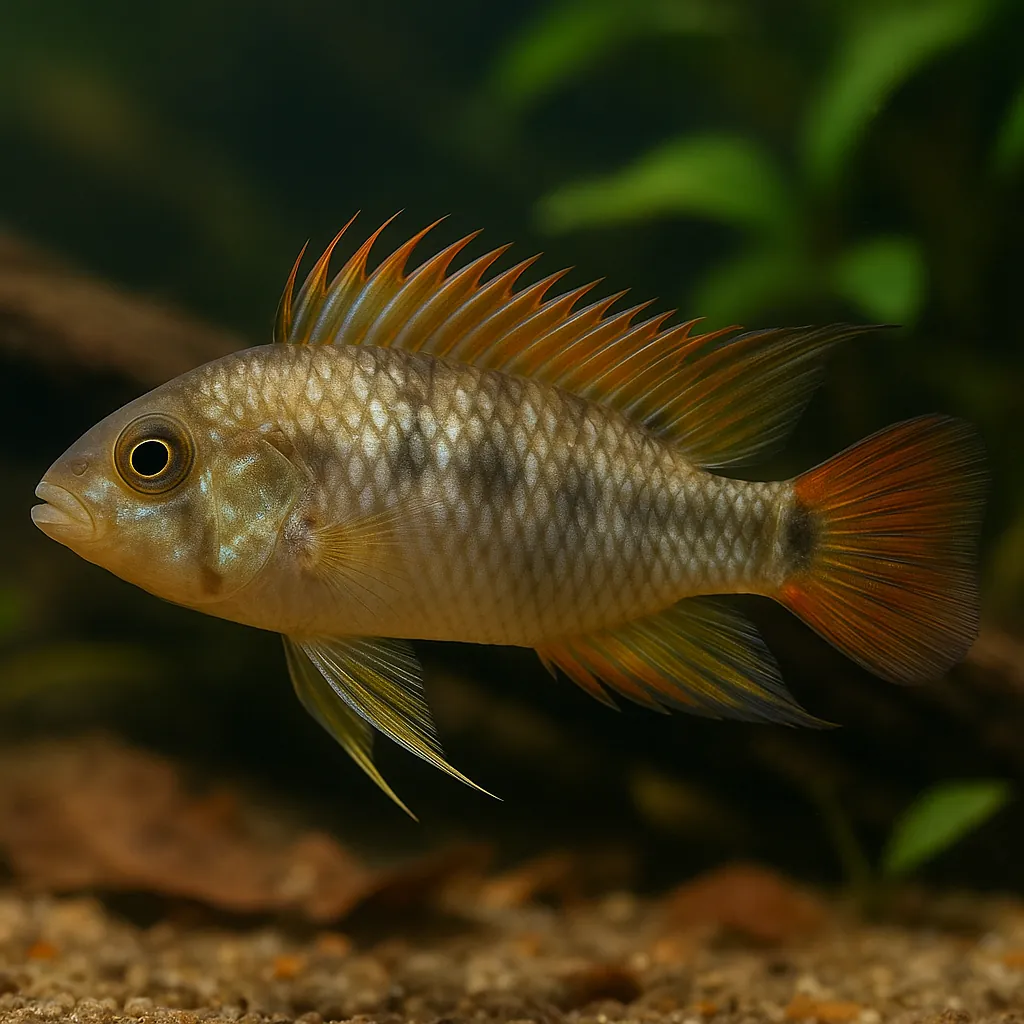
Cockatoo dwarf cichlid
Introduction
The Cockatoo Dwarf Cichlid (Apistogramma cacatuoides) is a vibrant and engaging freshwater fish, cherished by aquarists for its striking colors and dynamic behavior. Native to the Amazon River basin, this species is well-suited for community tanks and offers a manageable care level, making it an excellent choice for both novice and intermediate fishkeepers.
What makes the Cockatoo Dwarf Cichlid a popular choice among aquarists?
Its vivid coloration, relatively peaceful temperament, and adaptability to various tank conditions contribute to its popularity.
Is this species suitable for beginners?
Yes, with proper research and commitment to maintaining water quality, beginners can successfully keep Cockatoo Dwarf Cichlids.
Care and Environment
Providing optimal care for the Cockatoo Dwarf Cichlid involves attention to tank setup, water parameters, diet, and understanding their behavior.
What is the minimum tank size for a pair of Cockatoo Dwarf Cichlids?
A minimum of 60 liters is recommended for a single pair, ensuring adequate space for territory establishment.
What are the ideal water parameters for this species?
Maintain a temperature between 24°C and 28°C, pH levels from 6.0 to 7.0, and soft to moderately hard water.
How should the tank be decorated to suit their natural habitat?
Incorporate a soft, sandy substrate with plenty of hiding spots using driftwood, caves, and live plants like Java Fern and Anubias to mimic their natural environment.
Filtration should be efficient yet gentle, as strong currents can stress these fish. Regular water changes of 10-15% weekly are advisable to maintain water quality. Lighting can be moderate; however, providing shaded areas with floating plants can help replicate their natural, dimly lit habitats.
As omnivores, Cockatoo Dwarf Cichlids thrive on a varied diet. Offer high-quality cichlid pellets or flakes supplemented with live or frozen foods such as brine shrimp, bloodworms, and daphnia. Feeding small amounts two to three times daily is recommended to prevent overfeeding and maintain water quality.
Be aware that males can become territorial, especially during breeding. Providing ample hiding spots and visual barriers can help mitigate aggression. Monitoring their behavior and being prepared to separate individuals if necessary will ensure a harmonious tank environment.
Origin and Habitat
Originating from the Amazon River basin, the Cockatoo Dwarf Cichlid inhabits slow-moving streams and backwaters in Peru and Colombia. These environments are characterized by soft, acidic waters with temperatures ranging from 24°C to 28°C. The riverbeds are often covered with leaf litter, providing ample hiding spots and breeding grounds. The presence of submerged roots and dense vegetation offers shelter and foraging opportunities, which are essential for their survival in the wild.
What type of water bodies do they naturally inhabit?
They are typically found in small, shallow streams and lagoon-like waters within the rainforest.
How does their natural habitat influence their care in captivity?
Replicating their natural environment with soft substrates, ample hiding spots, and stable water conditions is crucial for their well-being in aquariums.
Temperament and Compatibility
Cockatoo Dwarf Cichlids are generally peaceful but can exhibit territorial behavior, particularly during breeding periods. Males may become aggressive towards each other and other tank mates if adequate space and hiding spots are not provided.
Are they suitable for community tanks?
Yes, when housed with small, non-aggressive species that occupy different tank levels, such as tetras, rasboras, or Corydoras catfish.
How can aggression be minimized in a community setting?
Providing a spacious tank with plenty of hiding spots and visual barriers can help reduce territorial disputes.
It's advisable to keep them in pairs or harems (one male with multiple females) to distribute aggression and promote natural behaviors. Avoid housing them with larger or more aggressive species that could intimidate or harm them.
Interesting Facts
The Cockatoo Dwarf Cichlid is known for its striking color variations, including forms like "double red" and "triple red," which are highly sought after by enthusiasts. Males often display elongated dorsal fins resembling a cockatoo's crest, adding to their visual appeal.
Do they exhibit any unique behaviors?
Yes, males may display "sneaker" behavior, where subordinate males mimic females in appearance to avoid aggression from dominant males and gain access to breeding opportunities.
How do they care for their offspring?
Females are diligent parents, often guarding and caring for their eggs and fry, while males may defend the territory.
These cichlids are also known for their adaptability, being one of the few South American dwarf cichlids that can tolerate a range of water conditions, including slightly alkaline environments.
Sources
All information in this article has been gathered from the following reputable sources:
Overview
Recommended Tank Size 26.4 Gallons (for groups of 6 or more) |
Minimum Group Size 2 |
Maximum Adult Size |
Minimum Tank Volume 15.9 Gallons |
Maximum Adult Length 3.5 inches |
Average Adult Length 3 inches |
Shoaling (6+ required) No |
Preferred Water Type Soft, acidic freshwater |
Temperature Range (°C) 24–28 |
pH Range 6.0–7.0 |
Water Hardness (dGH) 2–15 |
Typical Lifespan (years) 3 years |